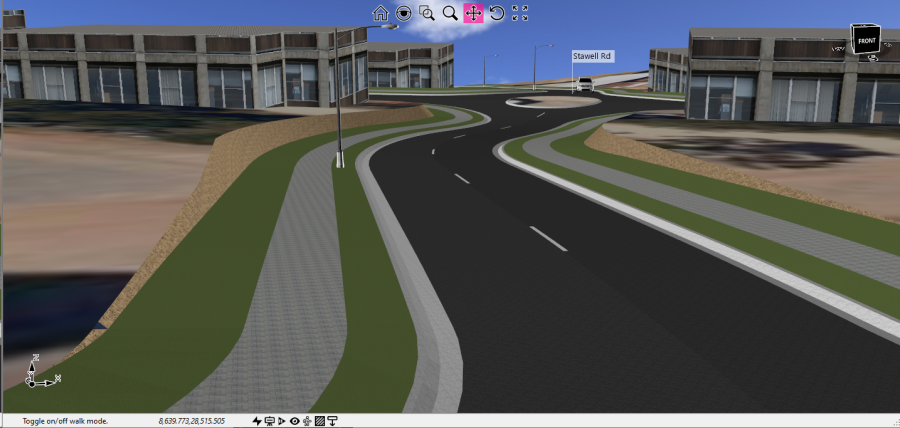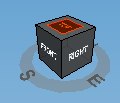Model Viewer
Icon: ![]()
![]()
Introduction
Model Viewer provides a spatially accurate, fully rendered, model of your surfaces and designs, updating as you make design changes and including analysis for sight distance. This is a full 3D environment with zoom, pan and orbit navigation. Any alignment can be immediately driven to assess visual and design outcomes. Sight distance analysis accounts for all surfaces, design features and objects in assessing whether adequate sight distance is provided for each road and intersection.
Video Help on Model Viewer
A video playlist on the use of Model Viewer is available here.
Mouse controls are used to navigate in the environment.
The Model Viewer is made up of three primary components:
A tabbed ribbon interface at the top of the form, containing commands to manage the display of items and to generate analysis and reports
A 3D view area displaying the models in the middle of the form
Command information text and view/explore commands at the bottom of the form
At the bottom left corner is a UCS icon, showing the orientation of the model. This is not editable.

Ribbon Interface Controls
The Ribbon is divided into a number of Tabs, grouped by functionality. For individual command help, please expand the relevant command using the Help navigation pane on the left. Ribbon tabs include:
- Home Tab: this tab manages the overall display of the environment and setting up how models should be displayed
- Analysis Tab: this tab provides access to model analysis including drive animations and sight distance calculations
- Objects Tab: this tab facilitates inclusion of 3D objects in the display
- Labels Tab: this tab enables the addition of labels in the drawing to describe design objects
- Point Clouds Tab: this tab manages the import and display of point cloud data
- CAD Tab: this tab allows for drawing (.dwg) files to be included in the model
- BIM Tab: this tab supports creating a BREP solid representation of the design, lofting shapes and export to IFC
- Outputs Tab: this tab manages outputs including screen shots and videos.
Bottom of form Controls
The bottom of the form provides the following (from left to right)
- Command prompts display bottom left to advise users of recent activity and to provide instruction on completing commands
- Coordinate tracking of the mouse location relative to the surface
 Fast Refresh toggle
Fast Refresh toggle
- Click to toggle on/off the 'fast refresh' mode (for updating the paste boundary between the base surface and other surfaces)
 Primary Surface display toggle
Primary Surface display toggle
- Toggle on/off the display of the Primary Design
 Play Animation
Play Animation
- When adding Object Groups in Model Viewer, users can animate objects along a path.
- Click this button to start and stop animating objects in the view
 Perspective/Orthographic
Toggle
Perspective/Orthographic
Toggle
- Toggle perspective view on/off using this icon. Orthographic views are more common when viewing CAD drawings in Model Viewer
 Walk Mode
Walk Mode
- Click to enter Walk Mode. Press again to exit Walk Mode
- In walk mode the viewer is placed on the surface.
- A form will display to provide navigation controls
- w,s,a,d buttons are used to move forward, back, left, right
- Left mouse button changes direction
- Press [Space] to jump.
 Transparency
Toggle
Transparency
Toggle
- Toggle on/off transparency display
 Ribbon display
toggle
Ribbon display
toggle
- Toggle on/off the display of the Ribbon command controls.
3D Model Navigation and Selection Controls
You can zoom, pan and orbit around the 3D environment, as well as execute commands to edit/review/analyse objects in the model.
Note: There are some specific selection techniques when particular commands are invoked, such as Select Objects. The mouse actions will be outlined for each command where it differs from the below default navigation behaviour.
Below is a description of the methods for navigating and selecting objects. The model environment includes a number of navigation controls which are outlined below:
Navigation Modes |
Sets different methods for navigation | ||||||||||||||||||||||||||||||||||
Default Navigation Mode |
By
default, Pan mode is normally enabled, with the following controls:
|
||||||||||||||||||||||||||||||||||
|
These navigation modes change what the Left Mouse selection will do | ||||||||||||||||||||||||||||||||||
Home |
Zooms to the model and displays a front-right corner view | ||||||||||||||||||||||||||||||||||
Magnifying Glass |
Puts a magnifying
glass over the view. |
||||||||||||||||||||||||||||||||||
Zoom Window |
Drag the left mouse button to form a window to zoom to | ||||||||||||||||||||||||||||||||||
| Zoom | Hold down and move the left mouse button to dynamically zoom in and out | ||||||||||||||||||||||||||||||||||
Pan |
Hold down and move the left mouse button to move left/right/up/down | ||||||||||||||||||||||||||||||||||
Orbit |
Hold down and move the left mouse button to orbit about the cursor position (set at the time of commencing the orbit) | ||||||||||||||||||||||||||||||||||
Zoom Fit |
Zooms to show the entire model | ||||||||||||||||||||||||||||||||||
|
The View Cube facilitates
rotation/orbit of the model via direct manipulation of the cube
in the display. Holding down the left mouse button over the cube will enable orbiting of the model. Hovering on the cube will highlight different 'parts' of the cube. Left click selection will change the view based on the 'part' highlighted. Samples below |
||||||||||||||||||||||||||||||||||
|
When a face of the
cube is highlighted, clicking on that face will zoom to it. In the example, left, clicking on the Top will show a top view of the model, oriented North. This is the Home (starting) orientation |
||||||||||||||||||||||||||||||||||
 |
When a corner is highlighted,
clicking on that corner will zoom to an isometric view. Clicking on a 'side' will set to that side. |
||||||||||||||||||||||||||||||||||
|
When the 'compass'
is highlighted, holding down the left mouse will constrain the
orbit to a horizontal rotation, while maintaining the vertical
rotation angle. Click on N, S, E, W to go to a front view at that orientation |
||||||||||||||||||||||||||||||||||
Shortcut Keys
Shortcut Key |
Command |
| CTRL + R | Refresh Model Viewer |
| CTRL + C | Create a copy of the selected Object |
| CTRL + T | Toggle the display of tooltips - the display of tooltips are managed in the Viewer Settings |
| CTRL + F | Toggle fast-draw of the base surface. This will improve redraw speed but the boundaries between the base and other surfaces will not be updated. |
| DELETE | Delete the selected Object |






